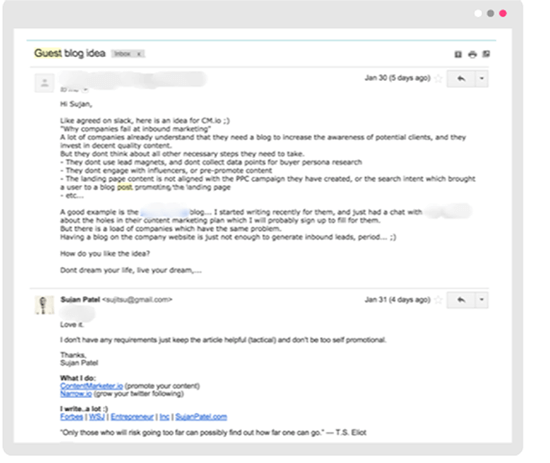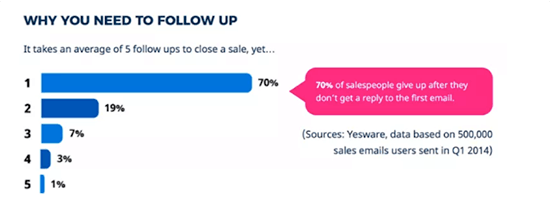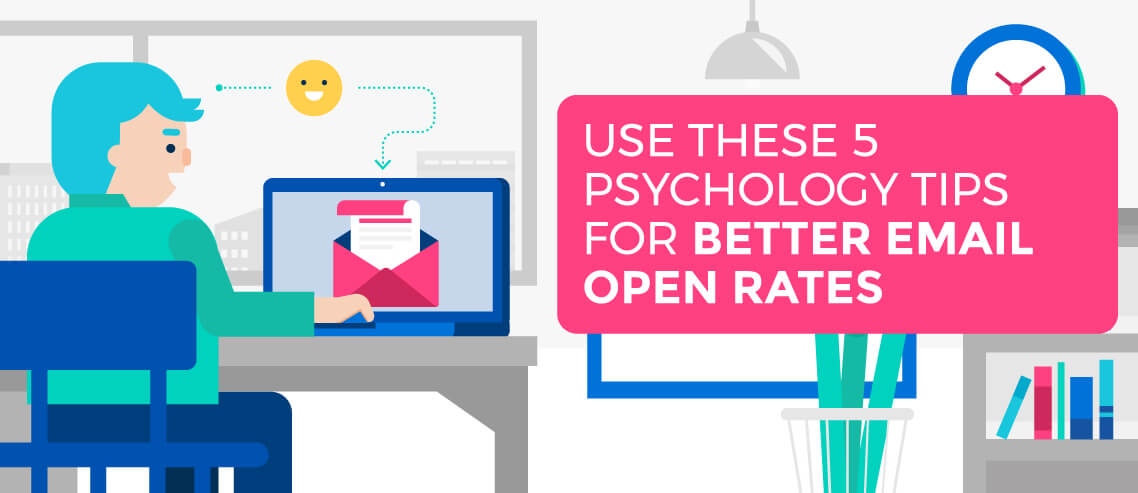Constructing the Perfect ‘Ask’ for Your Cold Emails

Contents
Cold emailing as a way to generate leads and connect with influencers is far from dead. It continues to be an effective way to reach out and quickly warm people up to land a ‘yes.’
Depending on your industry, the open rate for email hovers in the 20% range. 2017 email marketing statistics research found that business and finance email open rates are 20.97%, with a click-through rate of 2.73%. And the consulting industry shows an impressive 19.54% open rate, with a 2.26% click-through rate:

Image: Smart Insights
If you’re wondering how that all converts to revenue, Pardot reports that 20% of marketers can directly link their email operations to their company’s primary revenue source.
Email is also a relatively easy way to get someone’s attention. After all, you’re not asking them to meet you to go over a lengthy proposal or grab coffee and talk business with a stranger. Cold email just requires a little time, an investment in an email tool to stay organized and measure engagement, and a strategy.
Fortunately, there’s no big secret behind writing cold emails that you can’t learn for yourself. Here’s how to construct the perfect ‘ask’ for your cold emails that you can quickly implement in your next outreach strategy.
Go Deep with Personalization
Personalization is more than using a first name in an email. It’s also more than peeking at social media profiles to reference the city someone lives in or their favorite sports team. There’s nothing unique or compelling about gathering the same information everyone else has access to and uses in their own cold emails. Go deeper and dive into what someone really needs and wants to help warm up leads and influencers.
This high level of personalization immediately alerts the email recipient that you put concentrated work into figuring them out and catering your correspondence and offer just to them.
“Personalization means that you’ve thought about who this person is, how they see the world, what interests them, and what they want — you’ve developed a ‘theory of mind’ about the recipient,” says entrepreneur Tucker Max.
And while you should reflect a high level of personalization within the body of your email, you can also add a touch of personalization directly in your subject line to stand out.
Keith Ferrazzi – once the youngest CMO at both Deloitte Consulting and Starwood Hotels and Resorts, CEO of startup Ya Ya Media and a consultant to major clients like General Motors – advises using a subject line that immediately grabs attention. Measure your open rates with an A/B test of personalized subject lines that signal something you have in common with the recipient or the value you have to offer.
Make your subject line count. After all, the first click comes after someone sees it – and it intrigues them.
Don’t Go Directly for the Ask
With few exceptions, it’s not wise to go directly for the ask in your first email. Asking for the world right away will instantly get your email deleted, and leave your follow-up emails unread.
Instead, use the first email to warm someone up and start a conversation. That initial correspondence shows you’re interested in something other than just a ‘yes’ or a sale, and that you want a deeper understanding of the person and their needs to develop an ongoing business relationship.
Adam Lyons, the founder of insurance rate comparison startup The Zebra, embraces this concept and used it to score a major investment in his idea. His cold emails to investor and “Shark Tank” star Mark Cuban were a huge success and led to Cuban’s investment in his app.

Image: The Zebra
Lyons recommends keeping cold emails brief without front-loading your first one with a huge request.
“I wasn’t trying to close him in the email,” says Lyons. “Mark Cuban. I am sure he gets thousands of emails a day. If I try to just tell him my entire story and close it, that’s just not going to work. The game was, ‘Can I just flat out get a response, period?'”
[lyte id=”o_1-3CZgrsM” /]
What if you’re looking to warm up an influencer to guest post or to be a guest on a podcast? Try warming them up quickly by offering some kind of help without expecting anything immediately in return. Offer to research a problem they’ve discussed on their blog, connect them with someone they’re intent on meeting that you already know, or just offer some helpful feedback on how you enjoy their product or blog and share an idea. Once you’ve created a dialogue, you can segue into the ask in the third email.
Remember, there’s no hard-and-fast rule as to when you should make the ask when you’re building business relationships through cold email. Take a little more time if you think the relationship needs more finessing.
Strategically Reduce Friction
Make it incredibly easy for someone to say ‘yes’ by figuring out their level of interest from the start. Enable link tracking in your email tool to see when someone opens and clicks through your emails. This way you can predetermine if they’re interested and better tailor your follow-up emails accordingly.
Meanwhile, people who just delete your email probably aren’t going to give you the ‘yes’ you’re looking for.
Once you know your email recipient is engaging with your email content, go for the low-friction ask. This could be a relatively small, low-scale ask that can directly pave the path for a ‘yes’ or a sale down the road. In other words, you want to know if your lead is willing to buy the $100 product before immediately trying to upsell them on the $1,000 option.
You also don’t want to ask to guest post on a major influencer’s site or invite yourself to their podcast before you’ve started a relationship-building conversation first.
Reducing friction ultimately means providing convenience and ease for your lead or an influencer. If your ask requires them to jump through hoops or make an exception for you, they’re unlikely to ever say ‘yes.’ Steer clear of anything that requires multiple steps or a leap of faith, like connecting you to a major investor or network right off the bat.
Use Social Proof
Social proof can go a long way towards boosting your credibility and nailing the sale. Start by engaging with an influencer or lead online before you ever send that first email. This shows them who you are on social media, what your personality is like, and who you’re connected to, and also indicates that you’ve done your homework on them. It’s an effective step to getting the ‘yes’, and a strategy I go over in my Email Outreach Playbook. I’ve had people engage with me on Slack, a tool I use a lot, and it worked to land that ‘yes’ they wanted.

One way to harness social proof is to reference that you helped a competitor, or include a result you achieved for a client. You still want to make sure the email is highly personalized and structured around this person’s needs, but you can still work in some social proof and credibility builders. The easier you make it for leads and influencers to see what you can do and who you’ve done it for – the easier it will be to get that ‘yes.’
Another quick and easy way to show off your social proof is by adding links to your social media profiles right in your email signature. First, you need to make sure your LinkedIn profile – and any other channels your leads and influencers regularly frequent – are beefed up with your latest credentials, testimonials and case studies. Otherwise they’re likely to dismiss your social media presence altogether, or worse, get the impression that you haven’t done much of anything worth noting.
In fact, it’s worth mentioning here that if you don’t have much in the way of social proof, sometimes no proof is better than low proof, according to HelpScout’s Gregory Ciotti. As he explains:
“…When people come across a page (your sales page, a blog post, etc.) that has very low levels of social media proof, they may begin to think of it as less trustworthy. If you’re lacking in social proof at the moment, go for the ‘clean and uncluttered’ look. People won’t hold it against you.”
Follow-Up
It’s not unusual to need more than a couple of emails to get someone to say ‘yes.’ Yesware found that it takes 5 cold calls to close a sale, yet 70% of people stop emailing after the very first correspondence. However, you don’t necessarily need to follow up with everyone on your list and waste time with people who aren’t the right fit. Use your email tracking tools to see who is opening your emails. From there, you can determine who to follow up with and who to put aside.

The same concept goes for the emails landing in your inbox. If an influencer or lead has responded to past emails and still sounds lukewarm to your requests, it could mean they just need a few more emails to get on board.
Following up isn’t optional when you’re trying to make something happen in your business. Make follow-up an ongoing habit in your business and relationship building strategy to give your career a boost. And follow up even after you get that ‘yes’ or a sale. The relationship with that customer or influencer is far from over. Continue to engage with them and focus on their needs to create repeat business and referrals.
Cold email works great with a well-executed strategy that can help put more ‘yeses’ in your inbox than ‘nos.’ But it also helps to refine your approach to relationship building and lead generation. The more you put yourself out there and test your cold email open rates and click-throughs, the more insight you’ll have into what your customers really want to see in their inboxes – and what they respond to.
Images: Pexels,





